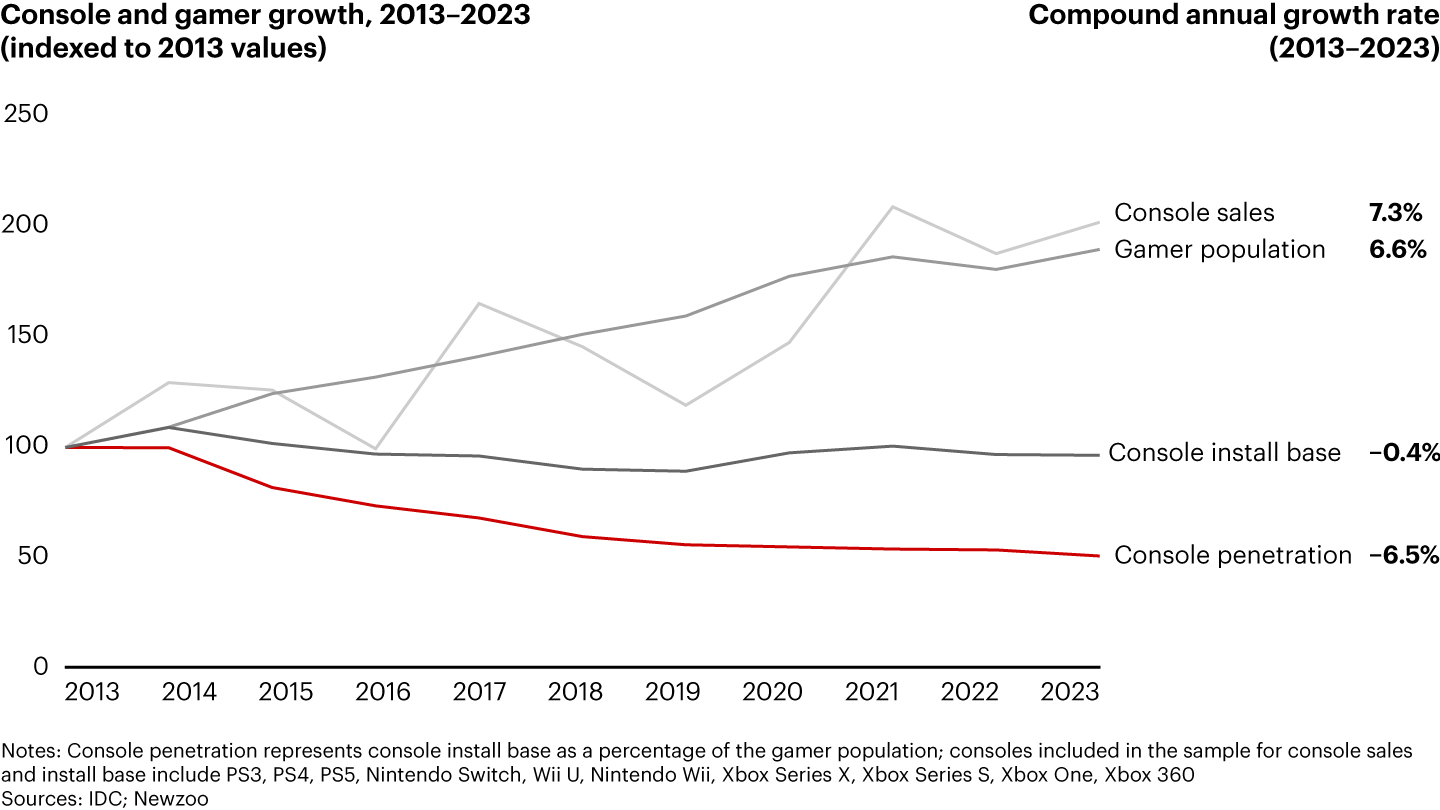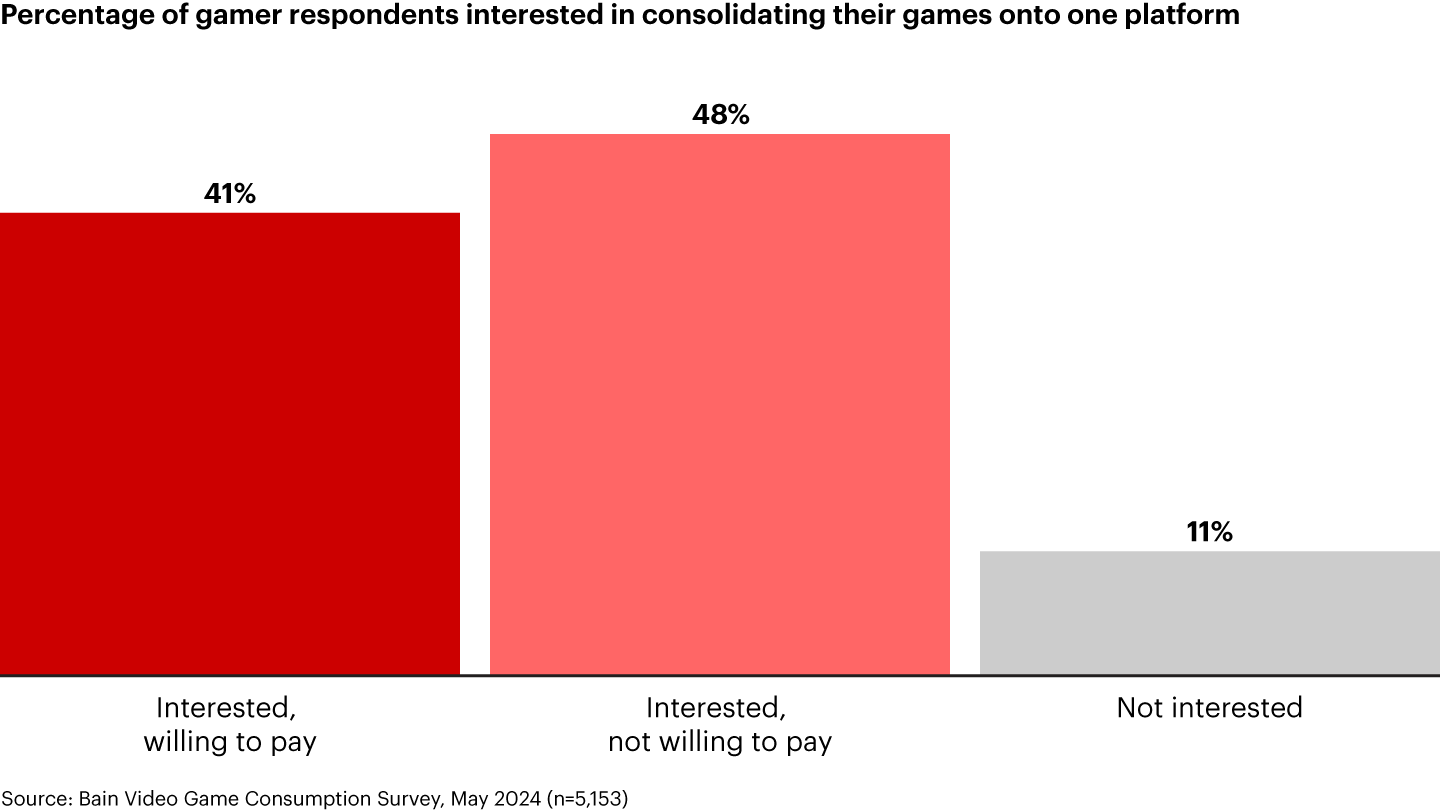Gaming Report
 }
}
Auf einen Blick
- Gamers increasingly identify with the games they play rather than the device they play on—a trend that will force game companies to develop new growth strategies.
- Advances in technology accelerate this trend: Low-latency, cloud-based gaming allows players to access games from a range of devices.
- Game developers are taking advantage of this change, moving away from platform exclusivity in pursuit of larger player bases.
- Marketplaces that consolidate games for players, sometimes for a fee, are likely to be the future battleground for control of the customer relationship.
This article is part of Bain's 2024 Gaming Report
Imagine a not-too-distant future when gamers can play seamlessly across almost any device: Start a game on their phone on the bus commute home from work, then, once home, drop their device next to a smart TV, pick up a controller, and rejoin the action on the larger screen.
This next step in the evolution of video gaming is just about here. As technology in non-gaming devices (mobile phones, TVs, non-gaming PCs) advances quickly and as cloud gaming becomes less expensive and more common, players will access games without a console, gaming PC, or other dedicated gaming device. Years ago, video entertainment followed a similar path: Consumers once had to rent or buy content to fit their hardware: VHS, Betamax, DVD. Netflix’s move away from mailing DVDs in 2007 signaled a shift to hardware-agnostic streaming platforms, and now viewers watch from anywhere, and increasingly on small phone screens.
Game console and device providers have been hearing for years that their industry will become device agnostic, but it seems, finally, to be taking shape, for a few reasons.
- Gamers want ubiquity. Players increasingly identify with the games they play (for example, Call of Duty or Fortnite) rather than the device they play on. Our recent survey found that 70% of gamers are playing on several devices and that 8 of the top 10 games are playable on multiple platforms.
- Technology gets better. Cheaper cloud infrastructure, more powerful mobile phones, and higher bandwidth networks all make it easier to serve games from the cloud to any device or screen.
- Developers are dropping exclusivity. As they pursue larger audiences and need to account for rising development costs, game makers are publishing titles across devices and marketplaces. For example, Final Fantasy publisher Square Enix said in May 2024 that it would shift away from its long-standing strategy of developing for Sony’s PlayStation and instead “aggressively pursue a multiplatform strategy” that includes Nintendo, Xbox, and PCs in addition to Sony’s platform. Other publishers, including Activision and Take Two, have signaled similar shifts.
Another sign that this shift is underway may be that although console sales continue to grow in absolute dollars, their penetration level has been flat for about a decade while the global gaming population has steadily increased over the same period (see Figure 1).


And while players say that they are active on multiple platforms, our survey found that 90% of them want to consolidate—and that half of those are willing to pay for it (see Figure 2). Gaming consumers are likely to settle on a handful of marketplaces, big game platforms (such as Roblox or Fortnite), or other integrated media platforms (such as Netflix Gaming).


Race for gamers’ attention
As that consolidation happens, a few industry leaders will capture the customer relationships, using that engagement to grab market share. Those companies (large and small) that fail to maintain a direct relationship with gamers will have to make strategic alliances to ensure that they can reach their audiences. Gaming companies will need to redefine their relationships with customers, competitors, and the various other players that make up the video game industry landscape.
- Game device makers: Those brands that have been defined by their proprietary hardware and the games exclusive to it may need to innovate and rethink their value proposition in order to maintain their relationships with their gamer customers. Given that 80% of gamers are playing mostly on non-console devices, these companies’ marketplaces may become more central to those relationships and their business models. They may want to take a two-pronged approach. First, protect and maintain their core hardware-based business by designing a highly innovative new generation of devices that provide high-quality, immersive experiences using extended reality technologies (e.g., virtual reality, augmented reality, etc.) and that natively and intuitively integrate with 4K smart TVs. The goal here should be to differentiate their game play from general purpose devices. Second, they’ll want to explore new business models, such as opening up their gaming environment to other players’ marketplaces, untethering their own marketplaces from their hardware (while providing the highest value proposition toward both gamers and developers), and generating new revenue streams from advertising.
- Game developers: As gamers concentrate their engagement on a few platforms, developers will want to decide whether to engage their players through their own direct-to-consumer platforms and marketplaces or through large, cross-device marketplaces, depending on their scale. They will likely accelerate efforts to develop cross-platform, cross-device games and features such as portable accounts and game libraries. This, of course, may require staffing up or upskilling internal teams to ensure the necessary technology capabilities. Strategic partnerships are also likely to become more important, especially for small and medium companies.
- Marketplaces and other distributors: Our recent survey found that 58% of gamers are already buying games from several online stores, and further disruption is almost certain. Large marketplaces such as Steam and battle.net are likely to compete in a land grab for new customers, who will have more choices but also face greater complexity. Expect to see a race for scale to become the dominant, cross-device marketplace, which will allow the leader to offer better economics to players and publishers as well as convey the right to own customer relationships.
An important first step in that direction will be for these companies to find ways to differentiate themselves with great interfaces, good prices, and occasionally swimming against the tide to offer exclusive games. Marketplaces will also want to build good relationships with game developers by offering reasonable fees, AI tools, LiveOps services, data analytics, and innovative monetization tools. Taking a more proactive approach to relationship management may require staffing up sales teams that help put more games on their marketplace.
No one can say for sure how long it will take the industry to move to a mostly hardware-agnostic model. But the companies most likely to win in the next chapter will be those with a clear understanding of their competitive advantage—namely, what has delivered success in the past and how that will play into the future. Forward-looking companies will invest in developing 5- to 10-year growth strategies that delineate how to capitalize on the opportunities—and mitigate the risks—inherent in this wave of disruption.
The authors would like to thank Nyla Brewster, Katie Chung, and Brandon Rogers for their contributions to this work.